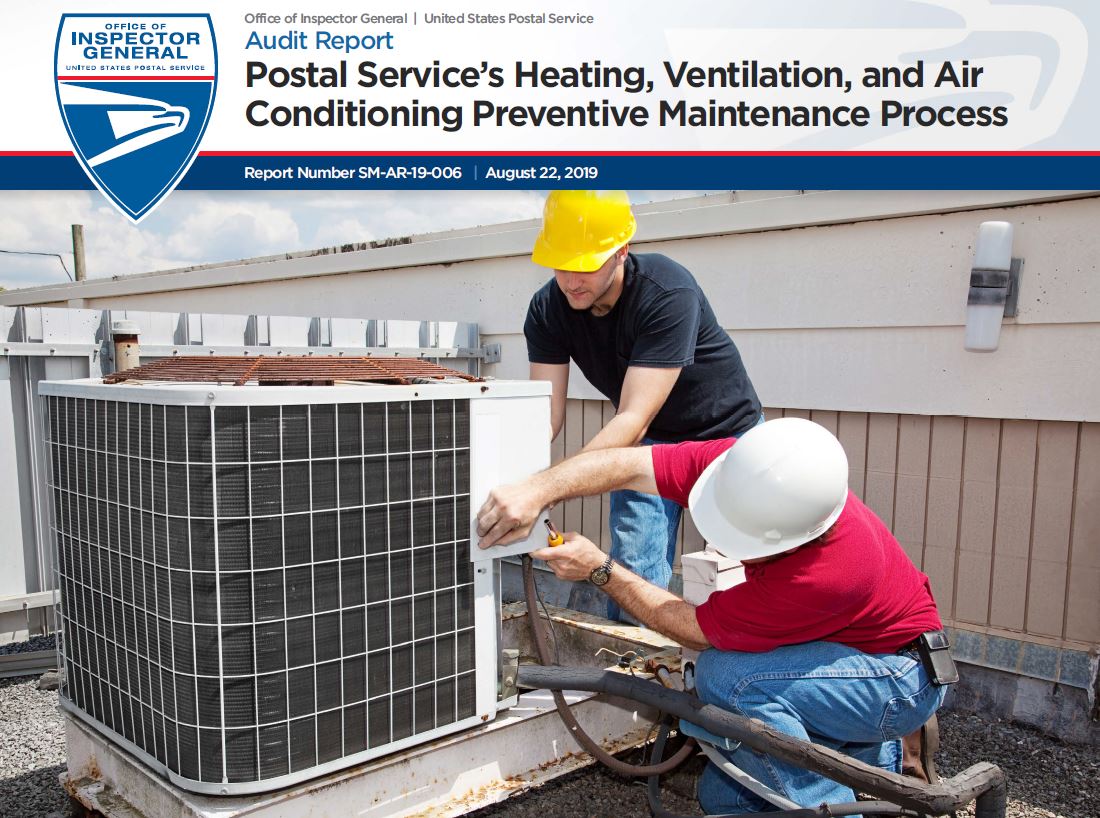Objective
As of February 2018, the Postal Service had 286 mail processing facilities nationwide, including 236 postal-owned and 50 leased facilities.
Postal Service policy requires that an effective and efficient preventive maintenance (PM) program be in place to ensure optimum performance, minimum downtime, and appropriate service life of building equipment. Mail processing facilities’ management is responsible for safely, efficiently, and effectively maintaining heating, ventilation, and air conditioning (HVAC) systems to ensure the safety and well-being of the building and its occupants.
Our objective was to evaluate the HVAC PM process at mail processing facilities. We reviewed a statistical sample of 118 facilities to assess HVAC PM performance for a two-year period from September 1, 2016, through October 31, 2018.
What the OIG Found
Preventive maintenance on HVAC equipment is not being consistently conducted per the designated PM route assignments. PM routes define the specific pieces of HVAC equipment to be serviced. In fiscal years (FY) 2017 and 2018, the electronic Maintenance Activity Reporting & Scheduling (eMARS) system generated 351,254 and 350,878 scheduled HVAC PM routes, respectively, at the 118 facilities we reviewed.
We noted 80 facilities (68 percent) in FY 2017, and 71 facilities (61 percent) in FY 2018 achieved below a 90 percent PM completion rate for designated PM route assignments. This means that 18 percent or more of the time scheduled HVAC PM routes were not completed. Per Postal Service building maintenance indicators, PM completion rates are measured by three indicators: >95% – Green; 90% to 95% – Blue; <90% – Red.
When a scheduled HVAC PM route is not completed, one of the following bypass codes is recorded in the eMARS system to indicate why.
- Code 0: No input, a system-generated bypass
- Code 1: Non-availability of resources
- Code 7: Operational requirements
- Code 8: Equipment not available for PM
A review of bypass activities indicated that bypass code 0 was the most utilized code at 67 percent in FY 2017, and 63 percent in FY 2018. Bypass code 0 is a system-generated code that indicates the PM was not conducted, management did not take actions to monitor due dates and assign the scheduled PM routes, and/or management did not enter an appropriate bypass code in eMARS.
Bypass code 1 was the second most utilized code at 32 percent in FY 2017, and 35 percent in FY 2018, indicating resources were not available to perform the scheduled PM route.
PM completion rates were not consistently 95 percent or greater due to several reasons: (1) shortages of staffing or building equipment mechanics resources, (2) other tasks being assigned a higher priority, and (3) management did not enter any bypass codes in the eMARS system, so it defaulted to code 0.
Since October 2015, management implemented a hiring freeze for Maintenance Operations’ building systems equipment positions; however, any hiring exceptions to fill the position had to receive headquarters Maintenance Operations approval. As a result, mail processing facility building equipment mechanics on the rolls decreased by 282 positions (14 percent) from 1,965 in FY 2015 to 1,683 in FY 2018.
Additionally, in some instances, maintenance management placed higher priority on other projects such as relocating mail processing equipment. Further, as identified by the Postal Service MS-1 Handbook revision team, some facilities adopted a ‘run to failure’ practice where repairs are performed when systems fail instead of performing recommended PM when due.
When an HVAC PM route is not completed, HVAC systems are at risk of not operating safely, efficiently, and effectively. In addition, the equipment is at risk of reducing its life expectancy, voiding the manufacturer’s warranty, and/or incurring additional repair costs. Additionally, when an HVAC PM route is not completed and the eMARS system automatically generates a code 0 bypass, sufficient data is lacking to assess why the PM was not conducted.
What the OIG Recommended
We recommended management: fill building systems equipment vacancies at each mail processing facility up to the authorized levels, create Standard Work Instructions to provide maintenance management detailed operating procedures and job aids related to their HVAC PM responsibilities, and implement a process to reduce the use of code 0, the automatic system-generated bypasses code in the eMARS system.
Read full report
Source: USPS Office of Inspector General

